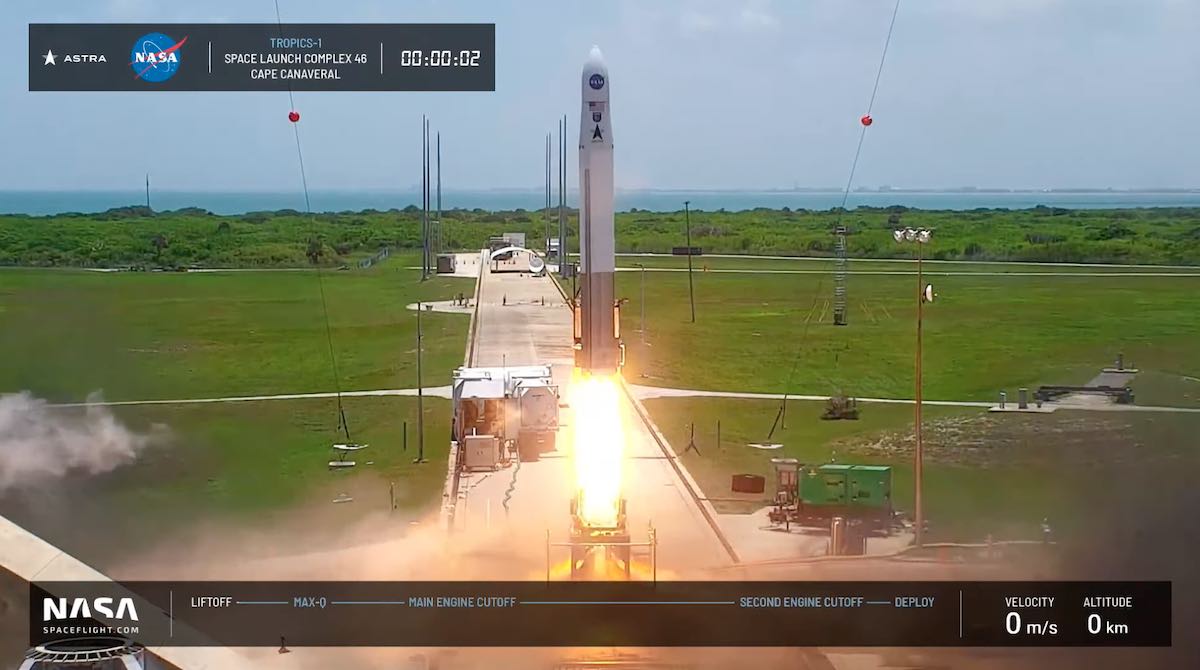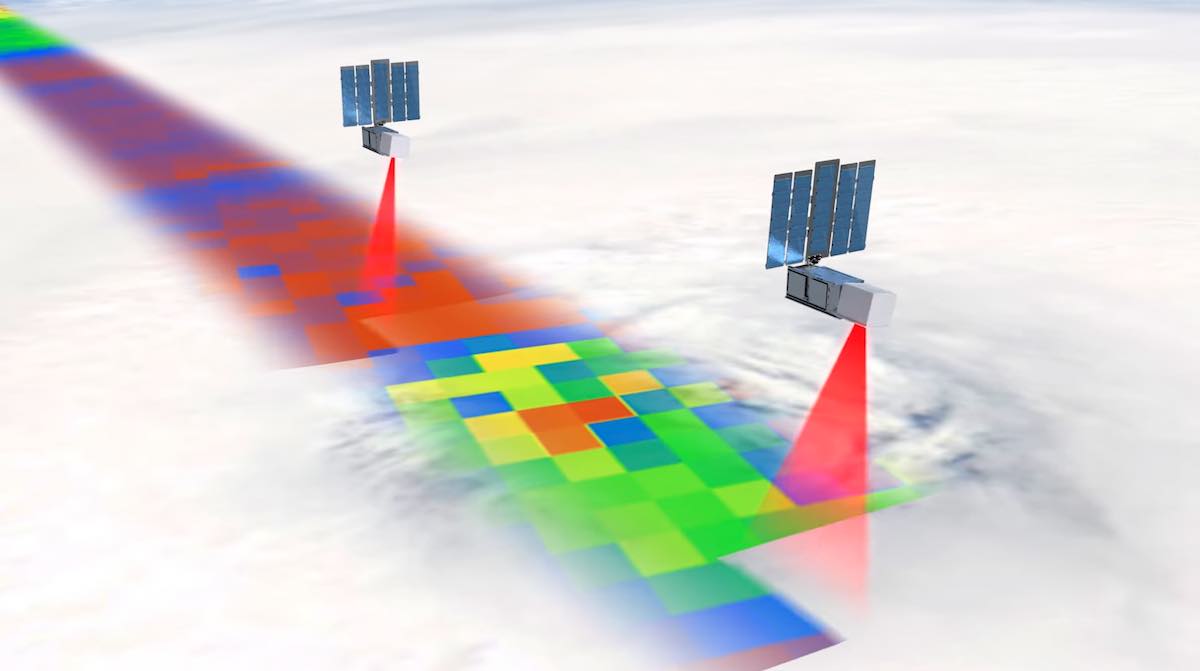
Two small NASA hurricane research satellites were destroyed after launch from Cape Canaveral Sunday when their commercial rocket, provided by Astra, prematurely shut down its upper stage engine before reaching the mission’s target orbit.
The twin nanosatellites — each about the size of a shoebox — were the vanguard of a planned fleet of six cyclone monitoring spacecraft to measure temperature, moisture, and other parameters inside hurricanes and tropical storms.
The TROPICS mission is designed to collect data on cyclones with higher frequency than possible with other satellites. The goal is to make measurements over hurricanes in repeating passes as often as every 50 minutes, up from four times per day with conventional weather satellites.
“We regret not being able to deliver the first two TROPICS satellites,” tweeted Chris Kemp, co-founder and CEO of Astra, a company founded in 2016 that focuses on small satellite launch services. “Nothing is more important to our team than the trust of our customers and the successful delivery of the remaining TROPICS satellites. We will share more when we have fully reviewed data.”
The loss of the first two TROPICS satellites isn’t a death knell for the mission. NASA officials said before Sunday’s launch that only four of the six satellites, or two of the three launches from Astra, need to work to meet the mission’s success criteria.
“Although today’s launch with Astra did not go as planned, the mission offered a great opportunity for new science and launch capabilities,” tweeted Thomas Zurbuchen, head of NASA’s science mission directorate. “Earth venture missions, like this one, are low cost opportunities to send NASA science to space. It also enables more opportunities for researchers to have access to space.”
The flight began with liftoff from Space Launch Complex 46 on Cape Canaveral Space Force Station at 1:43 p.m. EDT (1743 GMT), following a delay of more than an hour-and-a-half to clear a boat from the downrange hazard area and allow Astra time to ensure the proper conditioning of liquid oxygen propellant on the rocket.
The small-scale launcher, standing just 43 feet (13.1 meters) tall, quickly climbed away from pad 46 powered by five kerosene-fueled Delphin engines. Astra’s launch vehicle, called Rocket 3.3, is the smallest orbital-class satellite launcher currently in operation, standing less than one-fifth the height of SpaceX’s much larger Falcon 9 rocket.
The first stage steered the rocket east from the Cape Canaveral spaceport, then shut down its engines on time. A payload shroud jettisoned to reveal the upper stage and the two NASA research satellites, followed by stage separation and ignition of the upper stage engine.
The second stage’s Aether engine, also burning kerosene, was supposed to fire more than five minutes to propel the two NASA TROPICS hurricane research satellites into orbit. The rocket targeted an altitude of 357 miles (550 kilometers).
But live video from a camera on the upper stage showed the engine shut off at about T+plus 7 minutes, 21 seconds, more than a minute before the scheduled cutoff time. A telemetry display on the live video stream indicated the rocket was flying at an altitude of around 330 miles (532 kilometers) and a velocity of 14,707 mph (6,575 meters per second) when the engine turned off.
Astra says the upper stage of Rocket 3.3 failed after liftoff from Cape Canaveral.
The upper stage engine shut down early, as seen in this on-board video from the rocket, and the two NASA TROPICS hurricane research satellites did not reach orbit.https://t.co/B5InF8IbfP pic.twitter.com/99tEiRrJ15
— Spaceflight Now (@SpaceflightNow) June 12, 2022
The rocket did not have enough speed to reach a stable orbit, and the upper stage with the TROPICS satellites re-entered the atmosphere and likely burned up. Jonathan McDowell, an astrophysicist and expert tracker of spaceflight activity, tweeted that any surviving debris from the mission likely fell in the Atlantic Ocean west of Senegal.
The failure drops Astra’s record to two successful orbital flights in seven attempts. A previous launch in Alaska in March was the first Astra mission to successfully deploy functioning satellites into orbit, following a flight from Cape Canaveral in February that failed during the stage and fairing separation sequence a few minutes after liftoff.
Four more TROPICS satellites are built and ready for launch on two more Astra rockets. Before Sunday’s mission, those launches were scheduled in late June and mid-July, just in time to have the fleet collecting data for the peak of the Atlantic hurricane season.
“The next two launches need to work,” Kemp tweeted after Sunday’s launch failure. “Our team understands what is at stake.”
“Only four of the spacecraft need to work, so two rockets need to work,” Zurbuchen said in a meeting of the National Academies’ Space Studies Board last week. “This is a different risk level than what we do in so many other things in which we kind of focus, flatten the risk, and pound it down as much as we can. And that is deliberate. It’s deliberate because speed matters when you’re in the innovation game, and we want new capabilities and new assets and new tools.”
It wasn’t immediately clear how the failure might impact the schedule for the remaining TROPICS missions, but NASA said in a statement it expects to “pause the launch effort with Astra” during the investigation into Sunday’s failure, which will be led by Astra and the Federal Aviation Administration.
“We recognize the risks inherent in a new launch provider and will lend our assistance as needed,” NASA said in a statement.
NASA selected TROPICS for development in 2016.
“We’ve designed the mission from the ground up to build in some robustness to failure,” said William Blackwell, principal investigator on the TROPICS mission from MIT Lincoln Laboratory. “The choice of six satellites was made to give us some margin. We only needed four to meet our baseline requirements, so we can tolerate failures of the satellite or failures of the launch, or whatever, and we can still meet our requirements.”

“We’re trying to make improved observations of tropical cyclones,” Blackwell said in an pre-launch interview. “And what we’re really trying to characterize is the fundamental thermodynamic environment around the storm. So that’s things like the temperature, and the amount of moisture and precipitation intensity, and the structure around the storm.
“Those are important variables because they can be related to the intensity of the storm, and even potential for future intensification,” Blackwell said. “So we’re trying to make those measurements with relatively high revisit. That’s really the key new feature that the TROPICS constellation provides, is improved revisit of the storms.
“We’ll get, roughly every hour, a new image of the storm, and that’s about a factor of five-to-eight better than what we get today,” he said. “With these new measurements of rapidly updated imagery, we hope that that will help us understand the storm better, and ultimately lead to better forecasting of the hurricane track and intensity.”
TROPICS stands for Time-Resolved Observations of Precipitation structure and storm Intensity with a Constellation of Smallsats. The mission has a total cost of approximately $40 million, according to NASA. That includes $32 million for the spacecraft, instrument development, and post-launch operations, and the $8 million contract for three launches with Astra.
The TROPICS satellites were built by Blue Canyon Technologies in Boulder, Colorado.
“One of them weighs about 10 pounds, and is about the size of a loaf of bread,” Blackwell said. “So these are relatively inexpensive to build and test, and we can make them fairly rapidly, and they’re relatively inexpensive to launch.”
Each TROPICS satellite has a single instrument. A microwave radiometer, about the size of a coffee cup and spinning 30 times per minute, will create images of tropical cyclones, collect temperature measurements, and gather vertical profiles of moisture through the atmosphere.
Email the author.
Follow Stephen Clark on Twitter: @StephenClark1.
